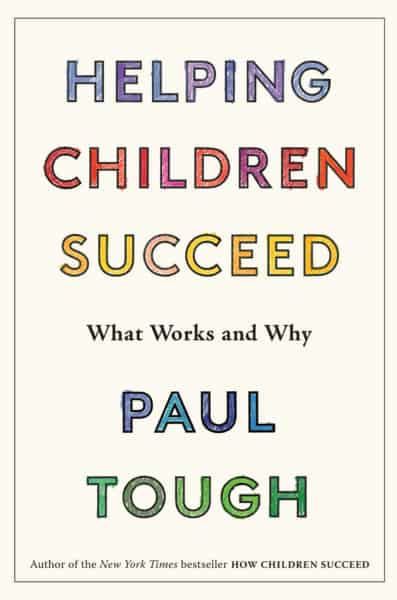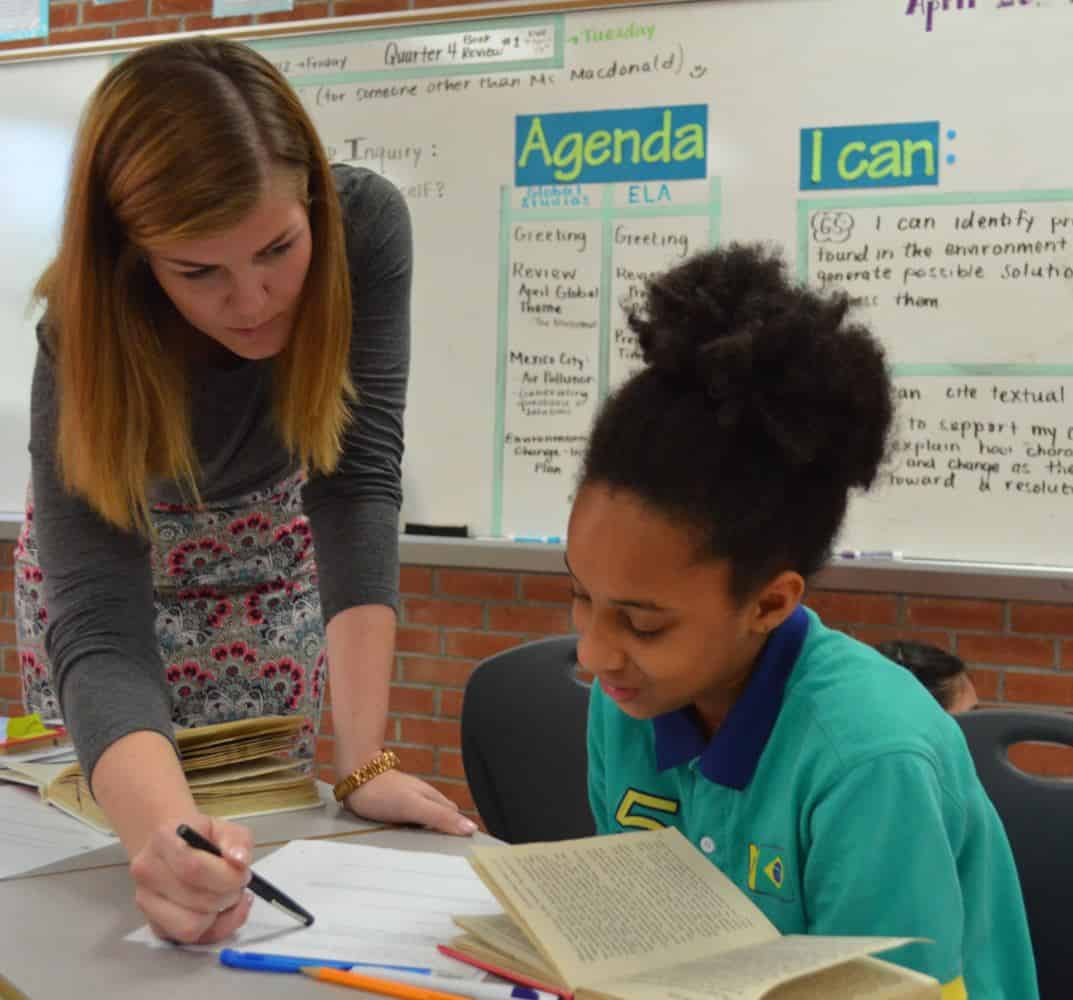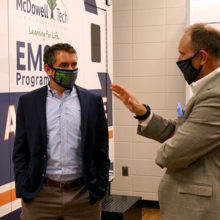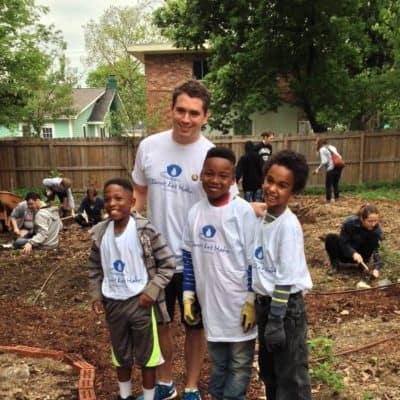Grit keeps coming up in education circles. The idea is that we can teach character, courage, and resolve to students in an effort to help them grapple with difficulties that arise in school and in life.
This idea of grit resonates with me. Grit got me to this day. It gets me through every day.
But different ideas and trends pop up frequently in education. Research indicates new approaches we might take to educate those who have proven difficult to educate. Policymakers move on from No Child Left Behind to Every Student Succeeds Act. Funders decide on new funding priorities, which drives the implementation of new strategies by nonprofits.
Superintendent John Farrelly of Edgecombe County Public Schools recently told us low wealth districts, like his, could take on 50 different initiatives with 50 different funding sources. It is tempting, Farrelly argued, to take on all of the programs as you work to find a path forward for every student.
I’ve had teachers tell me they feel as if they are on a hamster wheel of new programs as leaders cycle in and out of a school. It’s easy to understand why educators have initiative fatigue.
Yet the emphasis on grit, overcoming adversity, and developing resiliency feels different to me.
 Researcher and author Paul Tough recently released Helping Children Succeed: What Works and Why, which is building momentum for the ideas behind the “grit” boomlet. Tough draws upon decades of research on adverse childhood experiences to present a vision for why grit matters to the development of all children — particularly low-income students.
Researcher and author Paul Tough recently released Helping Children Succeed: What Works and Why, which is building momentum for the ideas behind the “grit” boomlet. Tough draws upon decades of research on adverse childhood experiences to present a vision for why grit matters to the development of all children — particularly low-income students.
Tough notes that within American public schools a majority of our students are now classified as low income. In the opening paragraphs of Helping Children Succeeds, he articulates why this should matter to us all:
Helping poor kids succeed is now, by definition, the central mission of American public schools and, by extension, a central responsibility of the American public.
This statement is a common theme as we travel the state of North Carolina.
In North Carolina, after all, we have even more students who are classified as low income — at least 53 percent using access to free and reduced price lunch as the measure. And those students are spread throughout the state in every district and every school. Additionally, we have pockets of extreme, lingering poverty.
One nonprofit leader recently told me, “The biggest question before us is can we educate poor children? Can we give them an opportunity to succeed?”
Tough notes that the Southern Education Foundation tracked a steady rise in low-income students from when they first began to track the numbers in 1989. At the time the low-income student population checked in at roughly one third of total students.
This trend, some of which is due to changes in the way we calculate the number, has revealed itself in my own on the ground reporting. In some areas of North Carolina the numbers have risen dramatically in a much shorter time frame. Hibriten High School, my alma mater, saw an increase in the percentage of students eligible for free and reduced price lunch from the low 30s to the low 50s in five years time during the Great Recession. The staggering rise in students facing trauma at home played a contributing role to Hibriten’s academic achievement numbers declining, in part, due to the fact that they had few strategies in place to deal with a changing student population.
The question before North Carolina could be taken from Tough’s book:
Is it possible for every child to have a chance at success in North Carolina?

Recently, my colleague Molly Osborne joined me for a discussion around ACEs, resiliency, and grit with Paul Tough.
 In Helping Children Succeed: What Works and Why, Paul Tough explains how educators have attempted to teach grit much as you might the history of the Revolutionary War. This was an understandable approach, as Tough noted when we spoke, yet as he explained, “It was simply not the most effective strategy — and part of it was most of the most effective teachers didn’t use words like grit and character. The reason is that these skills are not intellectual functions that you learn like riding a bike, or doing algebra, or knowing how to read, that you learn them and don’t forget. Grit, character, these are ultimately state of minds.”
In Helping Children Succeed: What Works and Why, Paul Tough explains how educators have attempted to teach grit much as you might the history of the Revolutionary War. This was an understandable approach, as Tough noted when we spoke, yet as he explained, “It was simply not the most effective strategy — and part of it was most of the most effective teachers didn’t use words like grit and character. The reason is that these skills are not intellectual functions that you learn like riding a bike, or doing algebra, or knowing how to read, that you learn them and don’t forget. Grit, character, these are ultimately state of minds.”
Tough shared that research indicated kids might persevere in algebra, but not in another math class. The research, he shared, elaborates that the state of mind which embodies grit is largely driven by motivation drawn from the student’s environment,including the student-teacher dynamic.
Tough told me that ultimately the environment is driven by key features including relationships, trust, and connectedness. He says the work assigned to students which must be challenging, meaningful, and rigorous.
If environment is critical, then it is environmental shifts which are essential.
One component of creating those shifts, according to Tough is to begin to alter teacher mindsets. We have seen this in Buncombe County where Student Services Director David Thompson and the district have begun to coach teachers to ask students “what is going on with you?” as opposed to “why did you do that?” when they are being disruptive. We have heard from Katie Dight in Cabarrus County where the local health alliance has worked to instruct educators to understand trauma. And we have seen what teaching with poverty in mind can do for an elementary school in Winston-Salem and a district in Hoke County.
Tough told us, “It is not a simple thing to shift mindsets. Teachers understandably take disruptive behavior personally. And when students misbehave they are going to react. My hope is that when teachers understand the research of stress on functioning that it will help them understand the students differently, and they can take it less personally, and respond with an understanding of what is going on in their environment, and what happened in early childhood.”
After all, disruptions in class are often cited as one of the frustrating elements of being an educator, yet we know from research that disruptive students often register as having a high number of Adverse Childhood Experiences:
“Adverse childhood experiences (ACEs) are potentially traumatic events that can have negative, lasting effects on health and well-being. These experiences range from physical, emotional, or sexual abuse to parental divorce or the incarceration of a parent or guardian. A growing body of research has sought to quantify the prevalence of adverse childhood experiences and illuminate their connection with negative behavioral and health outcomes, such as obesity, alcoholism, and depression, later in life.”
Research has indicated that children with four or more ACEs were 32 times more likely to have learning or behavior problems. In addition, a high number of ACEs has been found to correlate to absences, tardiness, anxiety and depression, and more. David Thompson explained to the Public School Forum of North Carolina how the fight or flight response within the minds of overstressed students can be the trigger for disruption. Thompson has urged educators and policymakers to consider the student with his or her head on their desk during a difficult lesson, the student who throws down their books in response to being stuck on an issue, and recall that their already stressed systems are reacting in a natural way.
Over the course of our conversation, Tough kept returning to the lifelong importance of environment for all of our students:
“Their environment shapes them, particularly how they do in school. The lesson for NC is to focus on improving the environment, particularly in the early years, particularly with an emphasis on interventions at home. And then working within the classroom to change the dynamic of the power structure so that students get a sense of belonging, and connection, so that they feel more motivated.”
It is clear that Tough’s work has led him to the conclusion that interventions must begin early in the life of a child. He spoke often of early childhood programs over the course of our conversation.
The early interventions that Tough indicated are illustrated by a study from Jamaica which he cites in his book:
In 1986, in a few of the poorest neighborhoods in Kingston, Jamaica, a team of researchers from the University of West Indies embarked on an experiment that over the past three decades has done a great deal to demonstrate the potential effectiveness of parent interventions. The experiment involved the families of 129 infants and toddlers who at the beginning of the study showed signs of delay in their development, either physically or mentally. The families were divided into four groups. One group received hour-long home visits once a week from a trained researcher who encouraged the parents to spend more time playing actively with their children: reading picture books, singing songs, playing peekaboo. A second group of children received a kilogram of a milk-based nutritional supplement each week. A third received both the supplement and the play-supporting home visits. And a fourth, a control group, received nothing.
The intervention itself ended after two years, but the researchers have followed the children ever since. (They are now in their early thirties.) The result: the intervention that made a big difference in the children’s lives wasn’t the added nutrition; it was the encouragement to the parents to play. The children whose parents were counseled to play more with them did better, throughout childhood, on tests of IQ, aggressive behavior, and self-control. Today, as adults, they earn an average of 25 percent more per year than the subjects whose parents didn’t receive home visits; by a variety of measures, including wages, these formerly delayed infants have now caught up with a comparison group of their peers who didn’t show any signs of delay in infancy.
Ultimately, Tough both in his book and in our interview shared that we must figure out how to educate parents on how to “serve and return,” an approach stemming from research that shows when children babble, laugh, giggle, cry, or speak, they gauge and respond to the response of their parents. Effective intervention strategies will teach parents how to have a productive response producing positive impacts for their children long term.
In short, Tough is calling on North Carolina to consider how we might build a better environment for all children to succeed from day one.
The hard work of shifting mindsets also carries over to the linkages between testing and accountability, according to Tough. His research has shown that environmental influences can include the stress that our teachers and administrators feel as well. He indicated that part of the drawback to our current testing system is that accountability raises anxiety for administrators and teachers, which is passed on to students. He shared his view that accountability policies often inadvertently narrow curricula which can then narrow the focus to test results. Ultimately the narrowing of what matters can have a negative impact on students. The end result is students feeling less challenged and motivated when doing the same work over and over again. This stress, Tough argues, filters down to students who are already facing stress as a result of their own ACEs at home.
This isn’t to say that Tough doesn’t believe that testing has a role in education. Rather, he told us the relationship between testing and accountability could well change with tests helping to serve as good diagnostic tools to measure progress.
Tough believes that we could create a future where we provide students and educators with more autonomy to drive motivation. We might do this, in part, by creating a different reward/punishment mechanism driving accountability and motivation differently.
Helping Children Succeed articulates a vision for education based off of strategies and programs that have proven effective at educating each child — including those who are facing severe trauma at home and in their neighborhood. In both North Carolina and the United States, with the majority of public school children qualifying for free and reduced price lunch, Tough’s argument that educating low-income children is now the central mission of education in this country needs to be considered.

For the past two years, I have taught 8th grade in Edgecombe County, a rural region located in the Eastern part of our state. The most recent statistics state that 85 percent of students in Edgecombe County qualify for free and reduced price lunch — almost a full 30 percent higher than the state average. Why does this matter? Because research shows that children who live under the poverty line are likely to have more adverse childhood experiences (ACEs) than their peers.
ACEs can take many forms: losing a loved one, experiencing homelessness, abuse (verbal, physical, or sexual), living in a violent neighborhood and witnessing crime, and even hunger. For children with high ACE scores, brain development can be significantly affected. Children who experience adversity throughout their childhood undergo what is called chronic early stress, or toxic stress.
In Paul Tough’s book, Helping Children Succeed, he details the effects of toxic stress that can be observed in the classroom: “fighting, talking back, acting up in class, and also, more subtly, going through each day perpetually wary of connection with peers and resistant to outreach from teachers and other adults.” When I read this, images of my students immediately popped in my mind, and I replayed numerous discussions I have had with my students over the past two years.
Suffice it to say that nearly all of my students have experienced trauma in their young lives. These experiences are more than just a moment in time for them — many are long-lived adversities, the scars of which are still fresh and throbbing. Some have more resiliency than others and are capable of piecing themselves back together after a traumatic experience. For those that are not as resilient, I worry what the future holds.
Tough explores the concept of teaching resiliency in his book, and comes to the conclusion that it may be a skill that cannot be explicitly taught, but instead shown through discussions and alternative lessons.
How do we teach resiliency?
Grit, curiosity, self-control, optimism, and conscientiousness are the noncognitive qualities that Tough identifies as necessary for building resiliency. The most effective ways he has seen these qualities “taught” is through indirect activities, such as chess or mentorship.
I have a dinner club that consists of three former students and their friends. We meet up about twice a month for dinner and conversation. All four young ladies have experienced a great deal of trauma in their young lives. I sat down with them the other day to discuss what I have learned about ACEs and resilience, and hear their take on the subject.
One, a former student of mine, became a mother to her first son this past January. When I asked her to tell me about her childhood, she began by saying, “tragedy, for me, started real young.” She then went on to depict a series of events in which her innocence was violated, her trust abused, and her faith tested. She is one of the brightest young minds I have had the honor to teach — but is quick tempered when conflict arises.
The other three girls told me similarly heartbreaking stories, all without making direct eye contact with me or each other. At the core of each girl’s account of trauma was a violation of trust by someone they love and care for. I asked how it was that they were able to trust me, both in the classroom and right then with their stories. One girl spoke up, “you just listen, Ms. Lauchert. I can always come to you because I know you’ll listen.”
When I dropped the girls off at home after dinner, I spoke with one of our community members, Kim, or as the girls call her, “Ma.” She explained that her house is known for being a safe place when someone is going through a hard time at their house. Kim has organized a gospel choir group that my four girls participate in, and sees it as a helpful way to help them cope with their stress. “So if you hear one of them humming a hymn, know that’s why,” she explained.
Kim is carrying out Paul Tough’s advice without ever having read Helping Children Succeed. She understands that sometimes the best way of dealing with stress is to get your mind off of it. When I asked Kim what teachers can be doing to help students who have experienced trauma, she told me, “some teachers need to listen to them instead of giving their opinions. These girls have something to say.”
This summer, I will be researching trauma sensitive learning policies and practices implemented by schools and districts in North Carolina and around the country. As a teacher, I am eager to learn more strategies for helping children succeed — both inside of the classroom and out.

Chapter 16 — Assessments
When you read through Deci and Ryan’s research on education, it quickly becomes evident that their discussion of motivational forces is very much connected to the conversations that educators have begun having about noncognitive capacities like self-control and grit. If we want students to act in ways that will maximize their future opportunities — to persevere through challenges, to delay gratification, to control their impulses — we need to consider what might motivate them to take those difficult steps.
Which brings me back to an idea I raised earlier: Perhaps we’ve been thinking about this new category of competencies all wrong. Maybe it’s less useful to consider them as akin to academic skills that can be taught and measured and incentivized in predictable ways and more useful to think of them as being like psychological conditions — the product of a complex matrix of personal and environmental factors. And perhaps what students need more than anything for these positive academic habits to flourish is to spend as much time as possible in environments where they feel a sense of belonging, independence, and growth — or, to use some of the language of Deci and Ryan, where they experience relatedness, autonomy, and competence.
So let’s return for a moment to the ongoing debate over noncognitive skills and how (and whether) to define and measure them. You may recall that the original impetus for focusing on this previously unexplored set of skills, in How Children Succeed and elsewhere, was the growing body of evidence that, when it comes to long-term academic goals like high-school graduation and college graduation, the test scores on which our current educational accountability system relies are clearly inadequate. Standardized-test scores are not irrelevant — students with high achievement-test scores do better, on average, in high school and in college than those with low scores — but those scores are not as predictive of success as other measures, including, most notably, GPA. A high school student’s GPA, researchers have found, is a better predictor of her likelihood to graduate from college than her scores on standardized tests like the SAT and ACT. This is likely due to the fact that GPA captures more than just cognitive ability and content knowledge. It also reflects the noncognitive behaviors and mindsets and traits that enable students to leverage their existing cognitive skills more effectively in school.
What is frustrating to those who want reliable measures of these newly important skills is that it is quite difficult to isolate and define, using the blunt instrument that is a student’s GPA, what exactly enables her to succeed. And in the current educational-policy environment — in which accountability, based on empirical data, is valued so highly — if you can’t clearly identify and measure skills, it’s hard to convince people to take them seriously.
This has led to an active effort by educators, researchers, and policy makers to analyze and categorize noncognitive skills in the same way we would reading and math skills. Most of us agree that the SAT math section does a pretty good job of measuring a student’s ability to do high school math (though there are quibbles, of course). But there is no similarly accepted measurement of a student’s level of grit or conscientiousness or optimism. This hasn’t stopped advocates from trying to develop those measures — and even to hold teachers and schools accountable for students’ performance on them.
The stakes connected to these efforts are growing. In 2013, the U.S. Department of Education granted a waiver from the narrow test-based-accountability requirements of the No Child Left Behind law to a coalition of eight school systems in California, together named CORE (for California Office to Reform Education). In the spring of 2016, schools in these eight districts began using a new assessment system that includes a measurement, based on student self-reports, of students’ growth mindset, self-efficacy, self-management, and social awareness. At the same time, officials around the nation have been trying to figure out how to respond to the new Every Student Succeeds Act, which replaced No Child Left Behind in December 2015 and requires each state to come up with its own accountability system that must include at least one nonacademic measure. CORE is seen as one possible model for states to follow.
The challenge facing administrators is that student self-reports, which CORE uses, are by definition subjective, and if in the future a state decides to hold its teachers or principals accountable for their ability to develop students’ noncognitive skills — if, say, next year’s salary is dependent in part on increasing students’ social awareness — there could be a temptation to influence or even manipulate the scores. In 2015, two leading researchers in the field of noncognitive skills, David Yeager of the University of Texas at Austin and Angela Duckworth of the University of Pennsylvania, published a paper investigating a wide variety of assessment tools for noncognitive skills. (Duckworth, as it happens, is the creator of the most widely used self-assessment measure for grit.) They concluded that when it comes to comparing students at one school or in one classroom with students in another, self-assessments just don’t work — especially in cases where they are used as tools for accountability.
But there is another approach to evaluating these capacities in students that is worth considering — and it’s one that might give us some new insights into the broader question of how to motivate struggling students to adopt more productive behaviors. A few years ago, a young economist at Northwestern University named Kirabo Jackson decided he wanted toinvestigate the ways we measure the effectiveness of teachers. He found a detailed database in North Carolina that tracked the performance of every single ninth-grade student in the state between 2005 and 2012 — a total of 537,241 students. The data followed their progress not only in ninth grade but through high school and beyond. Jackson had access to each student’s scores on the statewide standardized test, and he used that as a rough measure of their cognitive ability. Then he did something new. He created a proxy measure for students’ noncognitive ability, using just four pieces of existing administrative data: a student’s attendance, suspensions, on-time grade progression, and overall GPA. Jackson’s new index measured, in a fairly crude form, how engaged the student was in school — whether he showed up, whether he misbehaved, and how hard he worked in his classes.
Remarkably, Jackson found that this simple noncognitive proxy was a better predictor than a student’s test scores of whether the student would attend college, a better predictor of adult wages, and a better predictor of future arrests. Jackson’s proxy measure then allowed him to do some intriguing analysis of teachers’ effectiveness. He subjected every ninth-grade English and algebra teacher in North Carolina to what economists call a value-added assessment. First he calculated whether and how being a student in a particular teacher’s class affected that student’s standardized-test score. This is the basic measure of value-added assessment in use today; teachers in many states across the country are evaluated (and sometimes compensated or fired) based on similar measures. But Jackson went one step further. He calculated the effect that teachers had on their students’ noncognitive proxy measure: on their attendance, suspensions, timely progression from one grade to the next, and overall GPA.
What he found was that some teachers were reliably able to raise their students’ standardized-test scores year after year. These are the teachers, in every teacher-evaluation system that currently exists in this country, who are most valued and most rewarded. But Jackson also found that there was another distinct cohort of teachers who were reliably able to raise their students’ performance on his noncognitive measure. If you were assigned to the class of a teacher in this cohort, you were more likely to show up to school, more likely to avoid suspension, more likely to move on to the next grade. And your overall GPA went up — not just your grades in that particular teacher’s class, but your grades in your other classes, too.
Jackson found that these two groups of successful teachers did not necessarily overlap much; in every school, it seemed, there were certain teachers who were especially good at developing cognitive skills in their students and other teachers who excelled at developing noncognitive skills. But the teachers in the second cohort were not being rewarded for their success with their students — indeed, it seemed likely that no one but Kirabo Jackson even realized that they weresuccessful. And yet those teachers, according to Jackson’s calculations, were doing more to get those students to college and raise their future wages than were the much celebrated teachers who boosted students’ test scores.
The most obvious thing we can learn from Jackson’s study is that there are teachers out there making significant contributions to student success who are not being recognized by current accountability measures. What’s more, those measures may be skewing teacher behavior in a way that is on the whole disadvantageous to students. If you’re a teacher who is really good at raising noncognitive ability, but the teacher down the hall who is good at raising test scores is getting all the performance bonuses, you might be inspired to change your practices, despite the fact that you’re already providing profound benefits to your students.
But beyond this important policy implication is a second implication in Jackson’s study that is more relevant for our purposes: There is a more creative and potentially more useful way to measure noncognitive skills than what most researchers are currently focused on. Instead of laboring to come up with a perfectly calibrated new assessment tool for grit or self-control or self-efficacy, we can measure noncognitive capacities by measuring the positive outcomes that we know those capacities contribute to.
This conclusion then leads to an even deeper implication: It doesn’t really matter if we label these qualities grit or self-control or tenacity or perseverance, or whether we define them as character strengths or noncognitive skills — or anything else, for that matter. For now, at least, it may be enough to know that for the students in Jackson’s study, spending a few hours each week in close proximity to a certain kind of teacher changed something about their behavior. The environment those teachers created in the classroom somehow helped those students start making better decisions, and those decisions improved their lives in meaningful ways.
Because we tend to talk about school performance using the language of skills, we often default to the skill-development paradigm when considering these qualities: Teachers teach new noncognitive skills; students learn new noncognitive skills; those new skills lead to different behaviors. And if that’s the paradigm guiding our thinking, then of course we’d want to know exactly what those skills are, how to define them, how to measure them precisely, and how to teach them. What Jackson’s study suggests is that what is going on in those classrooms may not really be about students acquiring skills, at least not in the traditional sense.
So here’s a different paradigm, admittedly imprecise but, I would argue, a more accurate representation of what is happening in effective classrooms: Teachers create a certain climate, students behave differently in response to that climate, and those new behaviors lead to success. Did the students learn new skills that enabled them to behave differently? Maybe. Or maybe what we are choosing to call “skills” in this case is really just a new way of thinking about the world or about themselves — a set of attitudes or beliefs or mindsets that somehow unleash a new and potent way of behaving.
It’s not hard to see some parallels here with the research on parenting that I wrote about earlier. Parent coaches in programs like ABC and FIND don’t get hung up on which specific nursery rhymes and peekaboo techniques parents use with their infants; they know that what matters, in general, is warm, responsive, face-to-face, serve-and-return parenting, which can be delivered in many different flavors. That parenting approach, however it is carried out, conveys to infants some deep, even transcendent messages about belonging, security, stability, and their place in the world. And those mushy, sentimental notions find their articulation in the infants’ brains in precise neurochemical reactions: the formation of a synapse, the pruning of a dendrite, the methylation of a DNA sequence. All of which contribute, directly or indirectly, to that child’s future success in school.
The chain reactions taking place in the classroom may in fact be quite similar. Teachers convey to their students deep messages — often implicitly or even subliminally — about belonging, connection, ability, and opportunity. Those messages may not have the same measurable neurochemical effects on a ten-year-old brain as they do on a ten-month-old brain, but they do have a profound impact on students’ psychology and thus on their behavior.
When kids feel a sense of belonging at school, when they receive the right kind of messages from an adult who believes they can succeed and who is attending to them with some degree of compassion and respect, they are then more likely to show up to class, to persevere longer at difficult tasks, and to deal more resiliently with the countless small-scale setbacks and frustrations that make up the typical student’s school day. In the same way that responsive parenting in early childhood creates a kind of mental space where a child’s first tentative steps toward intellectual learning can take place, so do the right kind of messages from teachers in school create a mental space that allows a student to engage in more advanced and demanding academic learning.
Excerpted from HELPING CHILDREN SUCCEED: What Works and Why by Paul Tough. Copyright © 2016 by Paul Tough. Reprinted by permission of Houghton Mifflin Harcourt Publishing Company. All rights reserved.





